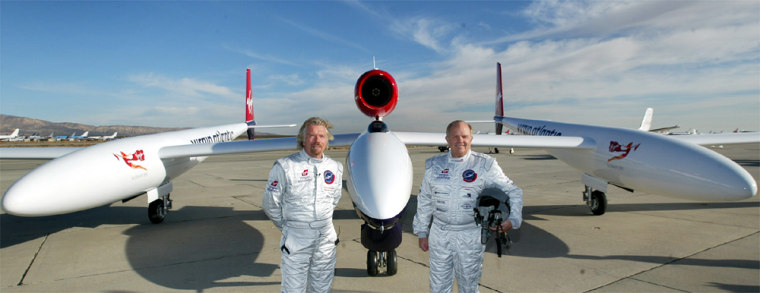Adventurer Steve Fossett and Virgin Atlantic chief Richard Branson unveiled an exotic jet Thursday in which Fossett will attempt the first solo, nonstop flight around the world without refueling.
The Virgin Atlantic GlobalFlyer, a single-engine jet with a 114-foot (34.7-meter) wingspan, was rolled out at Mojave Airport in the desert north of Los Angeles after four years of design and construction by cutting-edge aviation designer Burt Rutan and his company, Scaled Composites.
The first nonstop flight around the world on a single load of fuel was accomplished in 1986 when pilots Dick Rutan, Burt's brother, and Jeana Yeager took off in the Rutan-built Voyager from Edwards Air Force Base, Calif., and landed there nine days later.
One better with one less
Fossett, who became friends with Branson while trying to fly around the world in balloons, will try to go one better than the Voyager flight -- by going one less.
"In aviation, solo flights carry quite a distinction from co-piloted flights, they become more of an endurance endeavor, and become focused on the ability and the performance of a single person," he told The Associated Press.
"I will be totally responsible for flying the airplane at all times, so I carry one level more of responsibility," he said. "But that is not the only distinction. My flight is at a different technology level as well. It's a jet flight and it's also a much faster flight."
Fossett, who made the first solo balloon flight around the world in 2002, also holds various glider and jet aircraft records.
Voyager vs. GlobalFlyer
The similarities between Voyager and GlobalFlyer end with their common trimaran shape: a long wing with a stubby cockpit fuselage flanked by long booms with twin tails.
In addition to having a two-person crew, Voyager was piston-powered with propellers mounted in front of and behind the cockpit. Unpressurized, it flew slowly at low altitudes.
GlobalFlyer has a turbofan engine atop its single-seat, pressurized cockpit and will fly at speeds greater than 287 mph (460 kilometers per hour) and at altitudes up to 52,000 feet, where it will seek the jetstream's push to give it the range to fly around the world in just over three days.
The attempt to fly around the world will be made after numerous test flights, probably sometime between November and March when the jetstream will be favorable.
The flight will originate from somewhere in the central United States to allow the plane to remain over land while it gains altitude and to ensure that it will be over land at the end of the flight, when there is a risk of it running out of fuel.
Virgin Atlantic is sponsoring the flight, though the cost of the project remains secret.
"There aren't many great aviation records left to be had," Branson said in an interview. "This is perhaps, apart from space, the last great aviation record for Earth."
Branson as backup
Branson, whose own aviation feats include the first hot-air balloon crossing of the Atlantic in 1987, is a backup pilot for GlobalFlyer, but only if something catastrophic happens to Fossett.
"If anybody can do it, Steve is one of the few people in the world who can stay awake for 80 hours," Branson said, calling him "the greatest adventurer alive today."
Burt Rutan said GlobalFlyer is "absolutely" different from Voyager.
Voyager was 73 percent fuel by weight when it took off; GlobalFlyer will be 82 percent fuel.
"Now that doesn't sound like a big difference, but to a structural airplane designer, making something that is 82 percent fuel is extremely difficult compared to making something that's 73 percent fuel. This is a very, very difficult problem," Rutan said.
GlobalFlyer is expected to weigh about 22,000 pounds (10,000 kilograms) at takeoff and land 23,000 miles (37,000 kilometers) later after using 18,000 pounds (8,200 kilograms) of fuel. Internet users can track the project's progress via the GlobalFlyer Web site.
